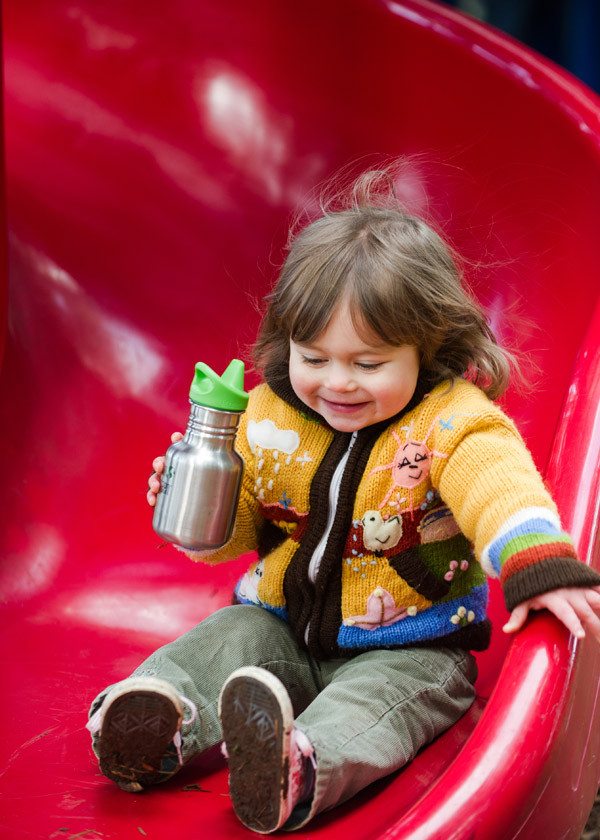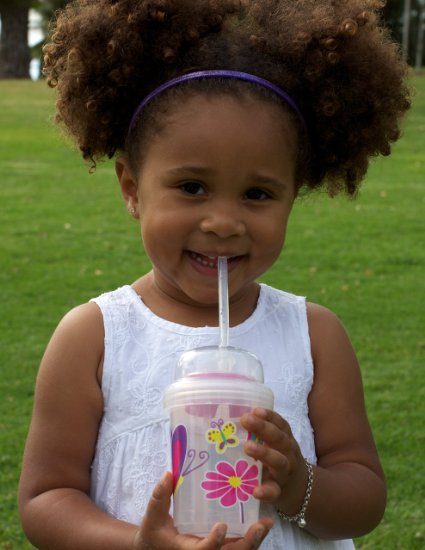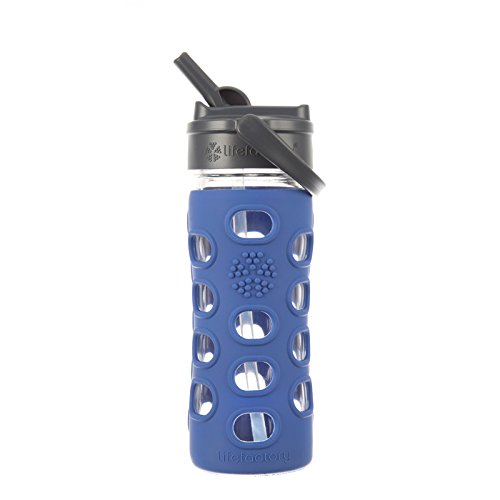 The transition from breast or bottle to sippy cup is a major one. It’s a transition to independent feeding and drinking skills. It’s a transition from babyhood to toddlerhood. But with so many different sippy products on the market, it’s hard to choose which one is made from the safest materials and is the best for oral motor development? What is the best sippy cup?
The transition from breast or bottle to sippy cup is a major one. It’s a transition to independent feeding and drinking skills. It’s a transition from babyhood to toddlerhood. But with so many different sippy products on the market, it’s hard to choose which one is made from the safest materials and is the best for oral motor development? What is the best sippy cup?
Photo credit: amseaman via Foter.com / CC BY-ND
Sippy Cup Materials
Sippy cup materials range from glass to stainless steel to plastic. We will review three different cups made from these different materials.
Parents have different reasons for choosing the material of their child’s sippy cup. Which is right for your family?
Stainless Steel
Pro: Stainless steel is a good option for sippy cups, as it is durable. Toddlers drop their sippy cups often. Stainless steel will dent, but it won’t crack or shatter. They are long lasting too!
Pro: Stainless steel is a safer choice than aluminum bottles, as aluminum needs to be lined to not leach into the contents of the cup. This lining is often made from hormone-disrupting chemicals like BPA.
Con: Most stainless steel is made in China. Chinese manufacturing has a range of social and environmental consequences, not to mention the carbon footprint of global transportation.
Glass
Pro: Glass is the safest material for our food and beverages. It does not take on flavors or leach.
Pro: Glass is easily recycled. Glass sippy cups shouldn’t end up in landfills.
Con: Glass breaks. When it breaks, little hands can be cut, as well as it is difficult to clean up.
Plastic
Pro: Plastic sippy cups are relatively durable. They can handle being dropped or even thrown, as sometimes a frustrated toddler may do.
Con: Plastic sippy cups do not last as long. They start to leak, can crack, and get funky if you put beverages other than water in them. Plastic holds odors and flavors. They deteriorate when washed in the dishwasher.
Con: Plastic contains hormone-disrupting chemicals. Even though most sippy cups are now BPA-free, the chemicals that replaced BPA are just as hazardous, like tritan.
To valve or not to valve?
Most sippy cups include a valve that prevents spilling. My children were always challenged by the valves. Fortunately, they are usually removable.
When teaching toddlers that cups spill, the valve gives a false sense. Sippy cups are handy though when traveling in the car.
Some experts advise skipping the sippy cup altogether and going straight to the cup.
The American Dental Association (ADA) recommends:
The best training cup for your child is one with no valve.((http://www.ada.org/~/media/ADA/Publications/Files/patient_36.ashx))
The ADA goes on to explain that sippy cups with valves are essentially baby bottles. They teach your child to suck, not sip.
Furthermore, sippy cups with valves can delay speech development or cause speech impediments. WebMD explains:
Toddlers could develop lisps and other speech problems from use of sippy cups, says a speech pathologist.
Sippy cups — the often character-themed training cups that come with a snap-on lid and hard spout — and/or thumb sucking can cause difficulty with articulation and clarity of speech in some children, says Sandra Holtzman, MS, a speech pathologist and certified orofacial myologist in Coconut Creek, Fla…
“If a child goes from the breast or the bottle to a sippy cup, they tend to drink it as if it were a bottle. They lie back or tip their neck in the usual manner, so it’s almost like drinking a bottle,” she says. “They have a hard object or spout with various shapes depending on the type of cup, and their bodies are tipped back. This hard object or spout misplaces the tongue and pushes the teeth out as the thumb can.”
Steer clear of sippy cups and use straws instead, she urges.
“Today, we are kind of spoiled and not as used to a mess when a cup spills, but that’s a mistake,” Holtzman says. Instead of cups with spouts, use cups with straws or simply place a straw in a paper or plastic cup, she says.((http://www.webmd.com/parenting/news/20080212/so-long-sippy-cups-hello-straws))
What is the best sippy cup?
The answer to this question really about what materials you feel are safe for your child’s health. Here are three sippy cups, one from each material described above, that we like.
 Stainless Steel Klean Kanteen Sippy Cup
Stainless Steel Klean Kanteen Sippy Cup
For my children, the Klean Kanteen sippy cup was the best! I loved that I could remove the valve, which is how we used it. It fit their perfect little hands, and it was quite durable. In fact, we still have them nine years later! They are interchangeable with other Klean Kanteen lids, so they make great little water bottles after your child has outgrown the sippy!
-
Spill Proof
-
Removable valve for easy cleaning
-
Dishwasher Safe
-
Safe, Durable, High Quality Materials
-
No BPA, No Lead, No Phthalates
-
18/8 food grade stainless steel doesn’t retain or impart flavors – liquids always taste fresh and clean
-
Free of BPA, phthalates and other toxins for a safe, plastic-free bottle
-
Slim design fits most bottle/cup holders and rounded corners make it easy to clean
-
Silicone spout with dust cover is designed for comfortable drinking and smooth flow
-
Can be used with Klean Kanteen Sport Cap 3.0 for older toddlers and the Loop Cap for additional options
The biggest drawback to the Klean Kanteen sippy cup is it is made in China.
 Glass Life Factory Sippy Cup
Glass Life Factory Sippy Cup
Just like the Klean Kanteen, the Life Factory Sippy Cup grows with your child. From baby bottle nipples to sippy cup lids to regular caps, these bottles are very versatile.
Extend the life of your Lifefactory 4 and 9-ounce Glass Baby Bottles with a set of Lifefactory Sippy Caps. These leak resistant caps offer steady flow control ideal for toddlers and older babies who are transitioning away from bottle feeding. Made of the highest quality, thermal shock resistant borosilicate glass from France, Lifefactory bottles offer a healthy alternative to plastics. These bottles are durable and shock resistant and the silicone sleeve provides a tactile gripping surface for little hands and helps protect against the occasional drop. Lifefactory Glass Bottles grow with your baby into childhood–they can be used with the range of Lifefactory nipples, sippy caps and leakproof flat caps–providing years of use. While very durable, Lifefactory bottles are still glass and are not unbreakable. Replacement bottles are available. All Lifefactory bottle components are made in the U.S. or Europe. The Sippy Cap is made in Poland. The silicone valve is made in the USA. All materials are BPA/BPS-free and phthalate-free.
Please note that the sippy lids have to be ordered separately from the bottles. The bottles do come in two different sizes.
We have several Life Factory bottles and wine glasses. We have only broken one over the past five years. They have been tossed around in backpacks, trucks, Gators, etc. The silicone sleeve is amazingly protective.
 Plastic nuSpin Sip & Spin
Plastic nuSpin Sip & Spin
This plastic sippy cup was sent to us to try. It has a unique design that spins when children sip encouraging hydration. The straw, rather than a valve, fits with the recommendations of dentists and speech pathologists.
Speech pathologist Rinda Graybill writes:
Swallowing
When a child drinks from a sippy cup vs. an open cup vs. a straw cup, what they do with the muscles of their mouth varies. A sippy cup is the same swallowing pattern as a bottle. An open cup and straw cup require more movement and control from the lips, cheeks, tongue and jaw. When drinking from an open cup or straw, the tip of the tongue elevates behind the top teeth to push the liquid back to swallow. When drinking from a sippy cup, the spout is in the way, impeding the tip of the tongue from elevating. This creates an abnormal swallowing pattern, rather than a correct one (Bahr, 2010).
Speech
As a speech pathologist, I want children to have great oral motor skills, and if a child has great oral motor skills, they are more capable of imitating speech sounds, words and sentences correctly. If a child uses a sippy cup excessively and doesn’t develop a mature swallowing pattern, then oral motor skills are not well-developed. Poor oral motor skills places a child at a greater risk for having difficulty saying certain speech sounds. Does this mean every child who has used a sippy cup has poor oral motor skills and poor speech skills? No.((http://day2dayparenting.com/the-truth-about-sippy-cups/))
My son has childhood apraxia of speech; my daughter had articulation problems as a toddler. I wish I would have know that the sippy cup was impeding their oral motor development!
The nuSpin Sip & Spin cup is made of BPA-free plastic and top rack dishwasher safe.
| Materials | Straws: FDA Grade Silicone Body: FDA Grade Polypropylene All Parts: Free of BPA, Phthalates, PVC, Nitrosamines, Latex, and Lead |
nuSpin Kids’ innovative straw cups make hydration healthy, easy, and fun for kids. Our Sip & Spin straw cup is especially fun, a pinwheel spins when your child sips to motivate hydration. We use valve-free silicone straws because they are the best choice for dental health, speech development, hygiene, and food safety. We use premium materials and manufacturing processes. Our cups are easy to drink from, simple to clean, and durable.
As mentioned before, I do have concerns with all plastics, especially for little children who by nature are more susceptible to toxins. I am also a little annoyed these spin cups seem to be gender oriented with one cup featuring flowers and one cup featuring trucks.
My recommendation for the best sippy cup
Perhaps the best sippy cup for children is not a sippy cup at all!
Given what I have learned about oral motor development, as well as sippy cup materials, I would have transitioned my kids from breast to cup skipping the sippy cup all together. For the on the go hydration, I would choose the
Lifefactory 12-Ounce Glass Bottle with Straw Cap and Silicone Sleeve, Cobalt. For home, I would use stainless steel Cub Stainless Steel Cups for Toddlers & Kids
to avoid contact with plastic lids and straws.
Many parents like cups with handles for their little ones, but I have found little hands quite capable of grasping small cups without them. They are less likely to bang them up and down on tables and counters when there are no handles.
I hope these recommendations help you and your child transition to the next stage!

Leave a Reply